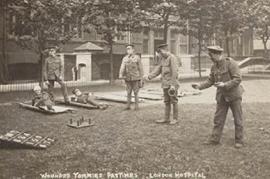Anniversary celebrations at Queen Mary in 2018
This year we have celebrated the 150th anniversary of women's admission to the University of London, along with the centenaries of Armistice Day and the Representation of the People Act 1918. Find out more about the Queen Mary community's role in these events.
150 years of women at the University of London
 In 1868, women were permitted to enrol for a ‘special examination’ course at the University of London. The University of London marked this anniversary with its ‘Leading Women’ campaign which named 150 exceptional female alumnae from the University of London’s colleges, 20 of whom have links with Queen Mary and our founding institutions.
In 1868, women were permitted to enrol for a ‘special examination’ course at the University of London. The University of London marked this anniversary with its ‘Leading Women’ campaign which named 150 exceptional female alumnae from the University of London’s colleges, 20 of whom have links with Queen Mary and our founding institutions.
Queen Mary alumnae recognised in the list include Constance Maynard, the first head of Westfield College; Pao Swen Tseng, the first Chinese woman to graduate from the University of London in 1916; and Dame Colette Bowe, Chairman of the Banking Standards Board and former Chair of Queen Mary College Council, who completed both her BSc and PhD in economics at Queen Mary College.
You can learn more about the women of Queen Mary on the Women at Queen Mary website, or see the 150 exceptional alumnae named in the campaign on the Leading Women website.
100 years since the Representation of the People Act 1918
 February 2018 was the 100th anniversary of the Representation of the People Act 1918, which extended voting rights in the UK and was the first time women were allowed to vote. Women finally gained equal electoral rights with men ten years later, in 1928.
February 2018 was the 100th anniversary of the Representation of the People Act 1918, which extended voting rights in the UK and was the first time women were allowed to vote. Women finally gained equal electoral rights with men ten years later, in 1928.
Many of the staff and alumnae of our founding institutions were involved in the fight for women’s right to vote.
Edith How Martyn, who was a lecturer in Mathematics at Westfield College, gave up her post to devote herself to the cause. She was arrested in 1906 for trying to make a speech in the lobby of the House of Commons and was one of the first members of the organisation to be sent to prison.
Baroness Mary Stocks, Principal of Westfield College, 1939-1951, was also known for campaigning for women’s suffrage prior to her appointment as Principal. She later contested the London University seat at the 1945 General Election.
The East End was well known for its active group of suffragettes. The East London Federation of Suffragettes – led by Sylvia Pankhurst – was based in Bow, a short walk away from our Mile End campus, and rallied for universal suffrage. There are still local sites that you can visit today, and you can see some examples here.
The centenary of Armistice Day
 1918 also marked the end of the First World War, which was celebrated on Armistice Day, 11 November 1918. Many male staff and students at Queen Mary’s founding institutions fought in the war, and you can see some of their stories in the East London College’s Roll of Honour. The Meanings of Military Service website gives more information about the University's role in the First World War.
1918 also marked the end of the First World War, which was celebrated on Armistice Day, 11 November 1918. Many male staff and students at Queen Mary’s founding institutions fought in the war, and you can see some of their stories in the East London College’s Roll of Honour. The Meanings of Military Service website gives more information about the University's role in the First World War.
Many male doctors were sent to work for the Royal Army Medical Corps during the war, which led to the recruitment of more female medical students. Dorothy Stuart Russell, Olive Gwendoline Potter, Dorothy Gibson, Gladys Wauchope, and Dorothy Armitage Waterfield were all admitted to study medicine at The London Hospital Medical College towards the end of the First World War. You can learn more about these women on the Women at Queen Mary Online webpages.